Your backyard is an important part of your home’s environment. Some well planned and functional landscaping has the potential to increase your property value while providing a year round special and joyful destination for your family and friends.
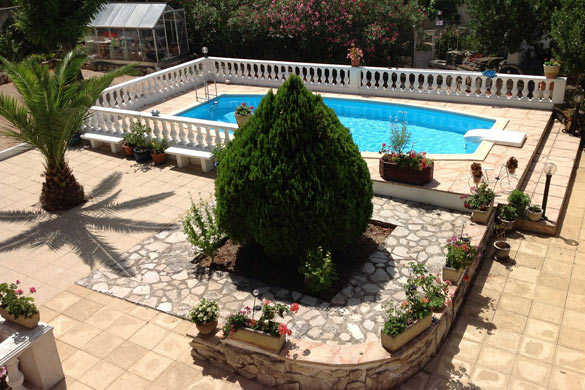
With all of the potential backyard landscaping possibilities, this project will require some careful and well thought-out planning. You will need to take into consideration the way you want to use your outdoor living space, the architectural features of your home, and the natural layout of your backyard.
The team at homeandgardeningguide.com has gathered the following ideas for backyard landscaping, as well as some design and planning tips.
Backyard Patio Ideas
For some, a backyard patio is just a slab of concrete with no higher purpose. However, with a bit of creative landscaping and a plan, your patio can be transformed into a destination spot for the whole family.
Planting Shrubs – Partially enclosing your patio can be accomplished by planting shrubs or bushes around its perimeter. As they grow and fill in the gaps, they can be shaped or draped with Christmas lights to create a fun or even romantic atmosphere.
Flowers and Plants – For a more open feel to your patio, consider planting a flower garden around it. Trellises can be erected for climbing vines, while decorative planters can be placed or hung in the corners (for covered patios).
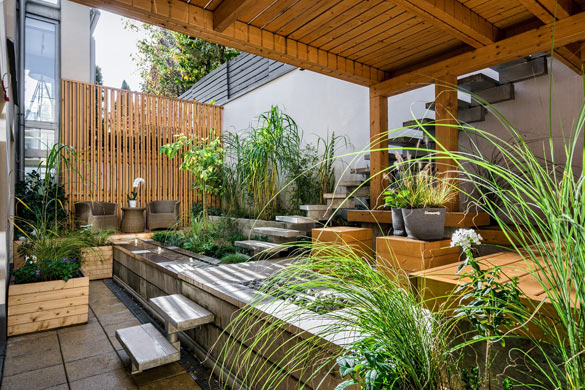
NOTE: According to toddsmariettatreeservices.com, when considering what species to plant and where to plant it, be mindful that trees and some larger shrubs have invasive roots. If planted too close to your patio, they could potentially break, buckle, or crack it.
Gravel or Stone Pathway – If your grill or fire pit are set away from the patio, create a gravel or stone pathway to them.
Garden Landscaping for the Backyard
Your backyard garden options are practically unlimited. Whether you choose flowers, spices, or fruits and vegetables, gardens create an engaging and useful space.
Bordering Gardens – Gardens can be used to accentuate landscaped grass designs, as walkway borders, or along the fence-line encompassing the backyard.
Planting gardens in this manner creates a sense of definition and gives the overall appearance of having depth.
Raised Gardens – Another fantastic way to create a dynamic appearance in your backyard is to plant raised gardens. This is accomplished by building or placing “box containers” in rows, squares, rectangles, or along the natural features of the land.
This is an ideal scenario for planting an organic garden. With organic gardening, one of the objectives is to have control over what goes into the soil. Having raised gardens naturally isolates the soil, giving you complete control.
Zen Garden – A zen garden is intended to be a place of peace and quiet – an area for meditation and self awareness. These gardens can take on a variety of shapes, colors and designs.
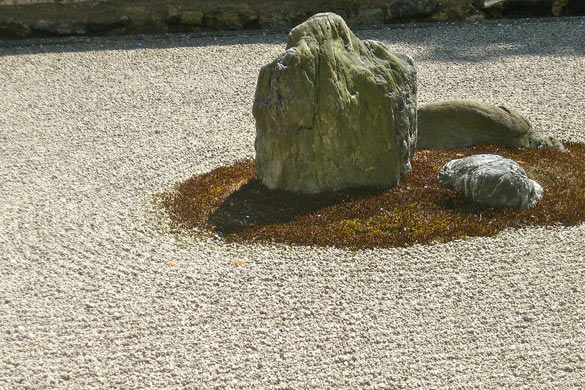
Commonly seen are those with a large flat area of white sand. Generally, in the sand there will be periodic large stones or islands of well pruned vegetation. Then in the sand, around the vegetation and to the border, a rake is used to create flowing designs.
Water features such as fountains, small streams, or waterfalls are often added to zen gardens to enhance their calming affects and peaceful vibrations.
Landscaping Trees in Your Backyard
Depending on the overall space and hardscaping in your backyard, trees can add shelter, shade, beauty, and grace all at once. It is important to know which species of tree you are planting in which location.
Roots – Many tree species have invasive roots that will grow far from the tree in search of moisture; this can take them under pathways, porches, patios, and even a home’s foundation. As the roots age, they thicken and begin to apply consistently growing pressure until they either die or break through whatever they are under.
Height – There is also the question of height. Overstory trees are those that reach 60ft and above, while understory trees will typically reach only 12-15ft in height. The use of both in landscaping is common practice and very rewarding as they reach maturity.
Deciduous or Evergreen – One very important consideration to make (when it comes to trees) is whether or not you want to rake leaves in the fall.
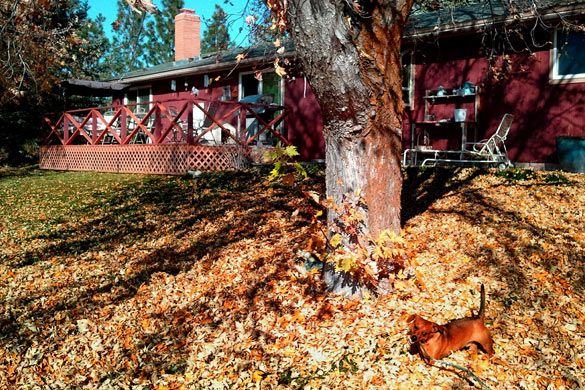
Evergreen trees are (as the name implies) green all year long. They will lose small portions of their foliage throughout the seasons, but nothing requiring a rake and leaf blower.
Deciduous trees will typically put on a color show as colder temperatures arrive, and will lose all of their foliage as the tree enters a state of dormancy through the winter months.
Backyard Fire Pit Ideas
It could be the middle of summer on an 85 degree night and for some reason, people will still flock to a fire pit. If having a fire pit in your backyard will provide a desired charm, take the following into consideration.
Location – A fire pit should not be located within 10 feet of any structure or flammable surface. Your trees are another concern, having a lit fire pit under the canopy of a tree is never a good idea.
Ideally, a fire pit should be positioned over gravel, brick, concrete, or other non-flammable surface.
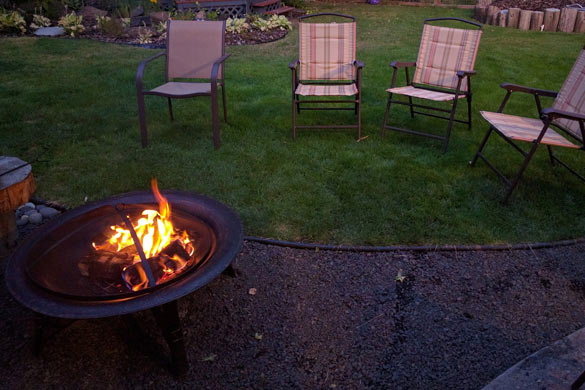
Surrounding the fire pit with non-flammable, weatherproof furniture is a way to create a “cozy” gathering spot for late night conversations, meals, or a place to congregate during half-time of the game!
Weather – Fire pits should not be lit under windy or adverse weather conditions. The wind could carry hot embers to surrounding structures potentially resulting in a fire.
Backyard Pool Ideas
Pools come in all shapes and sizes, above and below ground. With the installation of a pool, you must also account for its plumbing, the pump, and filtration unit locations.
Installing a pool creates opportunities for both landscaping and hardscaping. Choosing evergreen trees over deciduous ones will save both time and effort in the fall. Adding more hardscaping around the pool’s perimeter will also help in keeping it free of debris.
As with most backyard pools, they are typically centered and the rest of the landscape is designed around it.
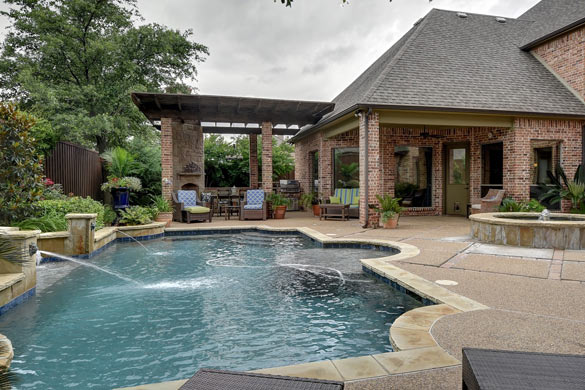
As pool installations can be a major expense, homeowners will often landscape their backyards placing trees, shrubs, gardens, and other permanent fixtures around the perimeter, allowing for the installation of a pool at a later date.
Landscaping Design and Plan
Design – The first step to successfully landscaping your backyard is to create a design. You can accomplish this in one of several ways.
- Hire a professional landscape company to do it.
- You can get a ruler, pencil, and paper to do it yourself.
- Download one of several free landscape design programs (some are drag-and-drop).
Getting the design and its dimensions right is crucial to the outcome of the job. When putting the design together, you should be aware of the following:
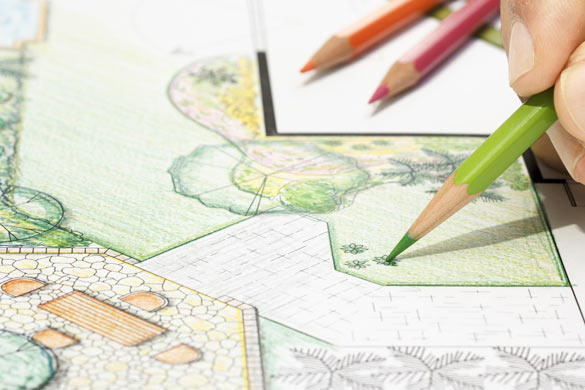
- Total area of the backyard.
- Location and occupied space of current vegetation.
- Location and dimensions of retainer walls and other structures.
- Location of underground utilities and their depth.
- Dimensions of structures to be added.
- Space required for new trees at their maturity.
- Designate outdoor use areas
As you build your ideal landscape design, know what your needs are and plan the area accordingly. Sketch as you go and try to visualize how the completed job will look.
Some people seek symmetry while others design to draw attention either to or from aspects of the landscape. However you intend to design yours, make certain that your proportions are right and that you account for the growth of your trees, bushes, and shrubs.
Plan – Now that you have a design and clear idea of how you want the end result to be, it’s time to make a plan. Components of that plan for the DIY homeowner should include (but is not limited to):
Legal Matters:
- Placing a request for the utilities company to flag underground utilities.
- Acquiring a tree removal permit if any trees are to be removed.
- Acquire land disturbance permits if your municipality requires them for private property.
Pricing for:
- New Trees, Bushes, and Shrubs
- Plants, Turf, Soil/Sand, and Gravel/Stone
- Equipment Rental
Dates:
- Target dates for any tree removal or activity requiring 3rd party activity.
- Purchase and delivery dates of new landscape components.
- Target dates for each phase of the new landscape installation.
This whole process can seem daunting and there are landscape companies that can take care of this process from concept to completion. However, if taken in steps, a DIY homeowner can complete their backyard and create a phenomenal aesthetic and cozy experience.
Visit www.homeandgardeningguide.com/gardening-landscaping/ideas/ for more lawn care articles, resources, how-to tips, and DIY ideas.